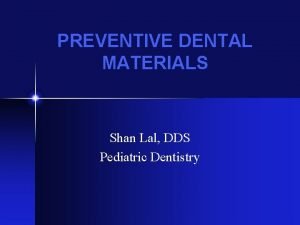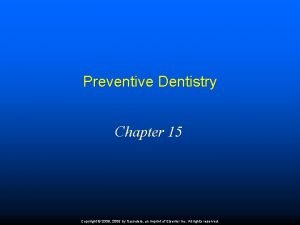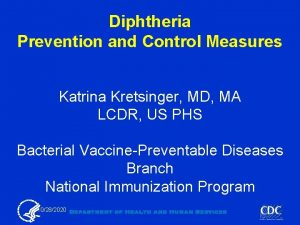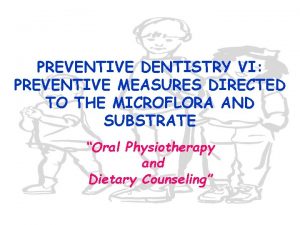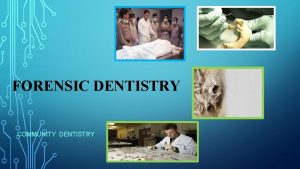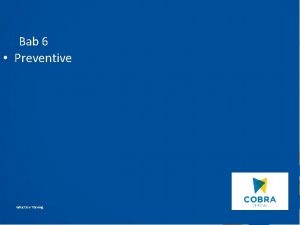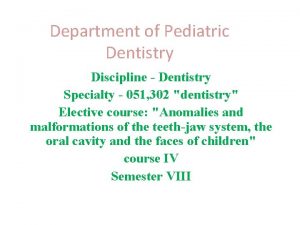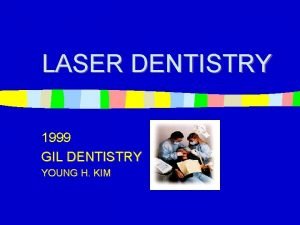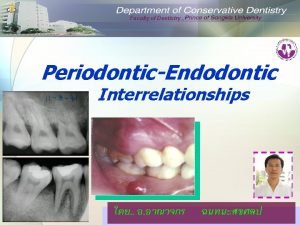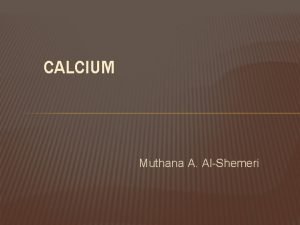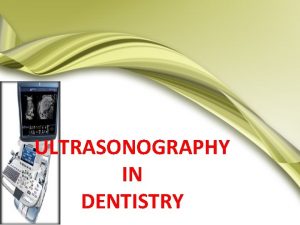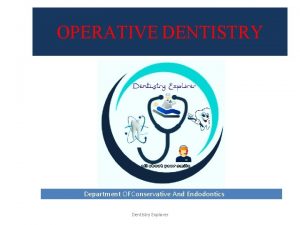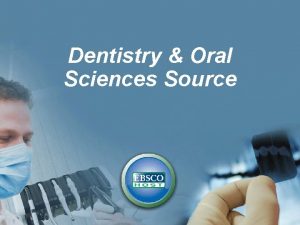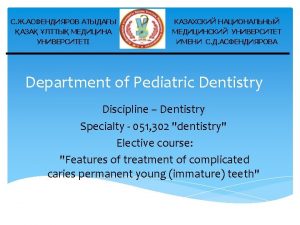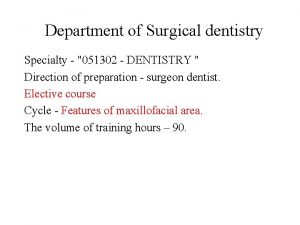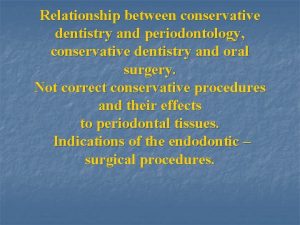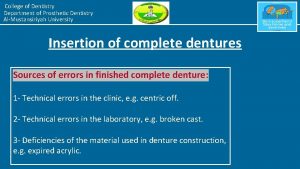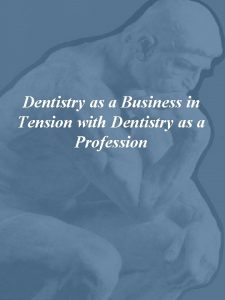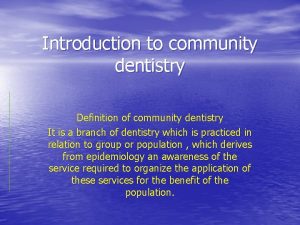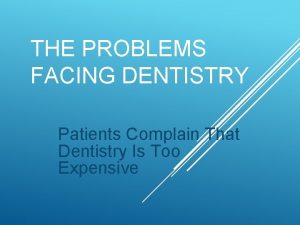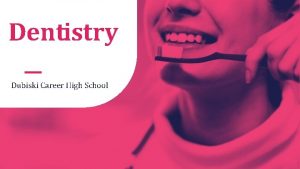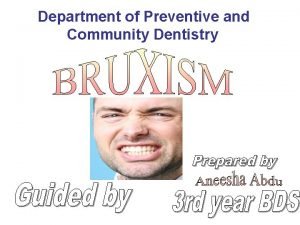PREVENTIVE DENTISTRY VI PREVENTIVE MEASURES DIRECTED TO THE


























- Slides: 26

PREVENTIVE DENTISTRY VI: PREVENTIVE MEASURES DIRECTED TO THE MICROFLORA AND SUBSTRATE “Oral Physiotherapy and Dietary Counseling”

ORAL PHYSIOTHERAPY (Oral Hygiene) • Elimination of the colonization of bacteria into dental plaques (oral biofilms) is possible through a program of oral physiotherapy/oral hygiene. • In spite of our emphasis on preventive measures directed to enhancing resistance of the tooth to caries attack (fluorides and dental sealants), and to dietary consultation to control the intake of fermentable carbohydrates, our major thrust must be at the oral microflora. • Although fluorides, sealants and dietary counseling are beneficial in reducing caries, they have little impact on periodontal disease. • Only a program of oral phyisotherapy prevents this disease process that accounts for more tooth loss than dental caries.

ORAL PHYSIOTHERAPY • For any oral hygiene regimen to be successful, the child and parent must be motivated to conscientiously comply with the necessary plaque removal procedures. • The procedures must be: – simple – effective – comfortable – require a minimum armamentarium, and a – reasonably brief period of time. • The parent--and child--must understand the etiology of caries and periodontal disease. • Motivation is accomplished by showing the parent and child, in their own mouth, the presence of the etiologic agents.

ORAL PHYSIOTHERAPY: Armamentarium • Disclosing solution (Two Tone) • Soft, nylon bristle toothbrush, with head size appropriate for the child. • Unwaxed dental floss


ORAL PHYSIOTHERAPY: Technique • • • A practical, pleasant, and simple method is introduced to the parent and child to enable them to determine the presence and location of plaque, as well as to check on subsequent removal of plaque. Little effort is made toward teaching a brushing technique; rather the parent and child are guided in learning to keep the teeth free of plaque. The “Bass technique” with the bristles of the toothbrush directed toward the gingival sulcus and moving in a circular motion should be a basic point of departure for showing the parent and child how to properly remove plaque. Flossing of the teeth must be accomplished by the parent through the early school years, as young children do not possess the manual dexterity to effectively floss. Because society (and we dentists) are so prone to think of oral hygiene as “brushing” one’s teeth, it is wise to always use the expression, when referring to oral physiotherapy, as flossing and brushing, given syntactic prominence to flossing!

ORAL PHYSIOTHERAPY: Effectiveness • The essential feature of an effective oral physiotherapy program is the thorough cleaning of the teeth frequently enough to prevent the accumulation of the adherent masses of plaque. • It is wise to be specific with regard to the time of day and length of time required for the oral physiotherapy technique. • It is generally recognized that one thorough removal of plaque each day is sufficient to prevent dental disease. • This thorough removal of plaque is best accomplished in the evening at bedtime. Generally family activities are less hurried and hectic at this time than in the morning, and the parent and child’s attention can be devoted to cleaning the teeth. • It is also wise to advocate one morning, after breakfast, brushing of the teeth as well.

ORAL PHYSIOTHERAPY: Participation • Preschool children: – Oral physiotherapy must be accomplished by the parent! • School children: – Oral physiotherapy must be directly supervised by the parent; in the early school years (6 -9) flossing must be accomplished by the parent, as generally children of this age group do not yet possess the manual dexterity to floss their teeth effectively. • Adolescents: – Oral physiotherapy must be monitored by the parent.

ORAL PHYSIOTHERAPY: Suggestions For Parents • The effective cleaning of the teeth requires time--approximately two full minutes. A novelty item which helps children focus on this time period is a small hour glass egg timer set on the bathroom shelf. • Disclosing solution should be used on a periodic basis to “spot check” plaque removal effectiveness.

ORAL PHYSIOTHERAPY: Suggestions For Parents • In cleaning the teeth, the parent should position themselves behind the child, supporting and controlling the head while brushing and flossing.

ORAL PHYSIOTHERAPY: Dentist Monitoring • Every appointment with the dentist should begin with a monitoring of the child/parent’s effectiveness in oral physiotherapy, and with reinforcement of its technique and imperative! • Monitoring should be done with the OHI-S indicator. The results should be reported to the parent and child in terms of percentage of the tooth surfaces free of plaque, as previously discussed in our session on oral diagnosis. • The child’s OHI-S should be entered in the progress notes of the chart at each appointment, to document progress in gaining and maintaining a plaque-free mouth.

THE “PROFESSIONAL” RUBBER CUP/PUMICE PROPHYLAXIS The need for a “professional” cleaning of the teeth with pumice and a rubber cup every six months has probably been one of the best “selling jobs” dentistry has ever accomplished--and with respect to children-- one of the least scientifically based.

THE “PROFESSIONAL” RUBBER CUP/PUMICE PROPHYLAXIS • There are three purposes of of a “professional” rubber cup prophylaxis: ” 1. To remove plaque 2. To remove stains from the teeth 3. To polish tooth surfaces roughened by long standing presence of calculus. • Polishing of tooth surfaces roughened by calculus must be considered the most significant of these reasons. – Stain is not an etiologic factor in dental disease, and – Plaque can and must be removed daily with a toothbrush and dental floss.

THE “PROFESSIONAL” RUBBER CUP/PUMICE PROPHYLAXIS • It is very difficult to justify a rubber cup/pumice prophylaxis in children. • Children only very infrequently have calculus. • Staining of the teeth is not a significant problem in children. • Plaque is best removed by flossing and brushing, and must be accomplished daily--not once every six months. • Parents gain a false sense of security that the dentist has “cleaned” their child’s teeth, with this resulting in some real therapeutic benefit.

THE “PROFESSIONAL” RUBBER CUP/PUMICE PROPHYLAXIS • More problematic than these issues is the actual harm done to the teeth by such a procedure. • The average dentist/hygienist will remove 0. 6 -4. 0 microns of enamel when performing such a procedure. • These outer few microns are the fluoride-rich areas of enamel, where fluoride has been deposited from the daily drinking of fluoridated water, using a fluoride dentifrice, and from previously professionally applied high potency topical fluorides. • A rubber cup/pumice prophylaxis also removes the acquired enamel pellicle, which acts naturally to diffuse acid when acid containing foods are ingested. While the acquired pellicle begins reforming immediately, it requires at least seven days to redevelop to maturity; that is, to reach its full potential to diffuse acid.

THE “PROFESSIONAL” RUBBER CUP/PUMICE PROPHYLAXIS • A rubber cup/pumice prophylaxis in the child patient should only be used when a definite indication exists, (1) subsequent to removal or calculus and (2) to remove stain. • When employed, it should only be done selectively on those teeth affected by the above indications, and a fluoride pumice should be used. • It should always be followed by a high potency topical fluoride application, in an attempt to restore the fluoride which has been removed. • However, there is some evidence to suggest that the deposition of fluoride on the enamel from a topical fluoride is not in the same form, and does not have the same degree of effectiveness as that fluoride deposited daily by the teeth’s coming in contact with low potency fluoride from fluoridated water and fluoride dentifrices. • Performing a “prophylaxis” on a child without applying a topical fluoride subsequently, is to actually render the child more susceptible to caries attack than before.

THE “PROFESSIONAL” RUBBER CUP/PUMICE PROPHYLAXIS • In lieu of the traditional and somewhat standard rubber cup/pumice prophylaxis, the dentist should remove plaque from the teeth prior to a topical fluoride treatment, in the same manner the parent and child are expected to remove it daily---with a toothbrush and dental floss.

THE “PROFESSIONAL” RUBBER CUP/PUMICE PROPHYLAXIS • Dentists are reluctant to abandon this traditionally accepted ‘therapeutic’ as parents and third party payers are willing to pay for the ‘service. ’ They are unwilling to pay for the removal of plaque by the dentist with a toothbrush and dental floss. • The usual and customary fee for a rubber cup/pumice prophylaxis on a child is $36. 00 -$45. 00. • Pediatric Dentistry’s ‘compromise’ on this issue (when a fee is to be accessed) is to use the rubber cup and pumice on a couple of tooth surfaces, specifically the distal buccal of the most distal maxillary molar, and the lingual of the most distal mandibular molar. These areas that are the most difficult from which to remove plaque with a tooth brush, and can be effectively reached with the contra-angle handpiece. • Using the handpiece for this does have the benefit of introducing the (young) child to a rotating instrument. However, this is a one time benefit.

THE “PROFESSIONAL” RUBBER CUP/PUMICE PROPHYLAXIS • How many dentists do you believe gain an informed consent to perform a rubber cup pumice prophylaxis? • Is such morally and legally obligatory? • How many parents would give an informed consent to such for their child, and pay for the procedure, once the dentist reviewed with them the scientifically- based indications, advantages, contraindications, alternatives, prognosis, and cost?

DIETARY COUNSELING • Diet plays a central role in the development of dental caries. • Observations both in man, and in animals in the laboratory, have clearly shown the relationship between frequent consumption of fermentable carbohydrates and caries activity. • The local effects of diet on plaque metabolism and specifically on acid production are considered to be far more important for caries development than the systemic (nutritional) effects of tooth development and saliva components.

DIETARY COUNSELING • Guidelines regarding the intake of fermentable (refined) carbohydrates should be provided to all parents regardless of the use of a comprehensive dietary analysis, with subsequent counseling. • Parents should be informed of the strong correlation between the consumption of refined carbohydrates and dental caries. • Key elements in the role of diet and dental caries is the frequency of ingestion of fermentable carbohydrates and the rapidity of their clearance from the oral cavity. • It is usually not feasible to completely eliminate all dietary offenders from the child’s diet; however, significant improvement can be made by advising the parent to follow certain guidelines. • Dietary insults to the oral environment pose much less of a problem to teeth that are plaque free; the old adage is true. . . “a clean tooth does not decay. ”

DIETARY COUNSELING: Helpful Ideas for Parents • CARDINAL RULE TO BE EMPHASIZED IN DIETARY COUNSELING WITH PARENTS: – “Parents are responsible for what children are offered… Children are responsible for whether and how much they eat. ”

DIETARY COUNSELING: Helpful Ideas for Parents • The rate at which refined carbohydrates are cleared from the oral cavity has direct bearing on their cariogenicity. Consequently, liquids, such as soft drinks, are not as great an offender as sticky solids, such as candies. • However, it is interesting to note that the average child receives 8% of his/her caloric intake from soft drinks. • It is not advisable to label foods as GOOD or BAD foods. This is sometimes done by dental professionals. Candy and ice cream and soft drinks and pie and cake are “BAD. ” Such labeling only destroys the professionals credibility, for children know these foods are “good, ” and that adults enjoy them as well. Rather, we should discuss with children times and ways that these good foods can be eaten and not be harmful to oral health.

DIETARY COUNSELING: Helpful Ideas for Parents • Candy snacks are the single greatest offender in fermentable carbohydrate consumption. Suggestions of appropriate alternative snacks are well-received by parents. • A popular and successful motivational strategy to assist in altering the deleterious candy eating behavior of children is to have a “CANDY NIGHT. ” Children are restricted from having candy except on one evening a week when they can have all the candy they want and can consume in one hour. Teeth are brushed and flossed immediately thereafter. Children love it! Their total consumption of candy is reduced overall, and it results in breaking the candy snack habit, while allowing the child to have a ‘foodstuff’ they love.

DIETARY COUNSELING: Dietary Analysis • A vigorous and comprehensive program of dietary counseling is reserved for those few patients for which such is required: – Children with extremely high caries susceptibility; those with numerous caries lesions affecting both fissures and smooth surfaces. – Children with a history of caries who are beginning full -banded orthodontics care. – Children who, for whatever reason, are unable to maintain a relatively plaque-free oral environment.

DIETARY COUNSELING: Dietary Analysis • When a comprehensive dietary consultation is to be accomplished, the parent is asked to keep a diary of the child’s food intake for five days. • This is then evaluated with the parent to demonstrate all of the exposures to refined carbohydrates the child has received, and to suggest alternatives. • Most parents are surprised at the frequency and degree of their child’s intake of fermentable carbohydrates.
 Syntax directed translation example
Syntax directed translation example Preventive dental materials
Preventive dental materials Chapter 15 preventive dentistry
Chapter 15 preventive dentistry Katrina kretsinger
Katrina kretsinger Repeated measures design vs independent measures design
Repeated measures design vs independent measures design Mật thư tọa độ 5x5
Mật thư tọa độ 5x5 Tư thế ngồi viết
Tư thế ngồi viết Thế nào là giọng cùng tên? *
Thế nào là giọng cùng tên? * Gấu đi như thế nào
Gấu đi như thế nào Thẻ vin
Thẻ vin Thơ thất ngôn tứ tuyệt đường luật
Thơ thất ngôn tứ tuyệt đường luật Sự nuôi và dạy con của hươu
Sự nuôi và dạy con của hươu Từ ngữ thể hiện lòng nhân hậu
Từ ngữ thể hiện lòng nhân hậu Thế nào là hệ số cao nhất
Thế nào là hệ số cao nhất Diễn thế sinh thái là
Diễn thế sinh thái là Lp html
Lp html Vẽ hình chiếu vuông góc của vật thể sau
Vẽ hình chiếu vuông góc của vật thể sau Làm thế nào để 102-1=99
Làm thế nào để 102-1=99 Lời thề hippocrates
Lời thề hippocrates Vẽ hình chiếu đứng bằng cạnh của vật thể
Vẽ hình chiếu đứng bằng cạnh của vật thể Glasgow thang điểm
Glasgow thang điểm đại từ thay thế
đại từ thay thế Quá trình desamine hóa có thể tạo ra
Quá trình desamine hóa có thể tạo ra Công thức tính thế năng
Công thức tính thế năng Khi nào hổ con có thể sống độc lập
Khi nào hổ con có thể sống độc lập Thế nào là mạng điện lắp đặt kiểu nổi
Thế nào là mạng điện lắp đặt kiểu nổi Các châu lục và đại dương trên thế giới
Các châu lục và đại dương trên thế giới

